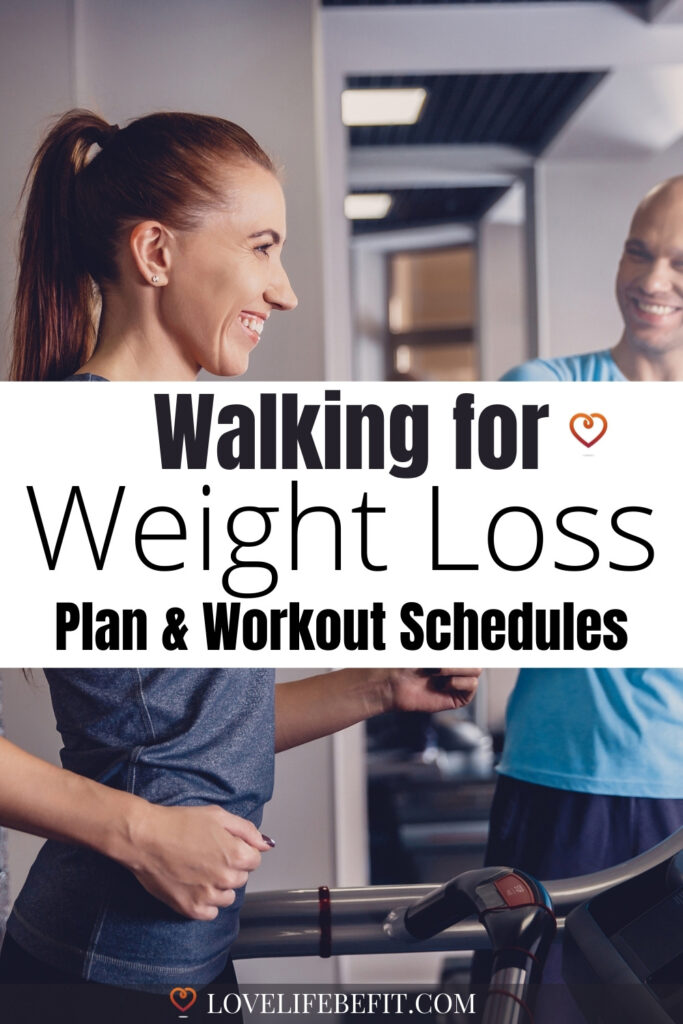Fat Burning Walking Schedule For Beginners
Following a walking for weight loss plan is a great way to calorie burn and hit your weight loss goals. A workout schedule helps you to stay on track. Setting targets and varying your workout helps to keep you motivated to exercise and eliminates boredom.

Benefits Of A Walking Workout Plan
The key physical activity guidelines recommended by the US Department of Health and Human Services and the Centres for Disease Control and Prevention are:
- Move more and sit less during the day.
- Participate in at least 150 to 300 minutes a week of moderate intensity, or 75 to 150 minutes a week of vigorous-intensity aerobic physical activity. More is better.
- Do muscle-strengthening activities of moderate or greater intensity that involve all major muscle groups on 2 or more days a week.
Combining a walking schedule with body weight strength training is an excellent way to hit these targets and improve your physical health.
Overall Health Benefits – Walking For Weight Loss
Take up walking for weight loss and enjoy the positive effects of improved health and fitness:
- Improved Fitness Level – a brisk pace increases your heart rate and improves your cardiovascular health.
- Burn Calories – Walking for weight loss is one of the best ways to burn calories as part of a weight loss plan.
- Protection Against Diseases – Regular walks help protect against heart disease, stroke, high blood pressure, cancer, and type 2 diabetes.
- Stronger Bones and Muscles – walking helps protect against osteoporosis and improves the strength of core and leg muscles.
- Great for Mental Health – Improves moods and helps you sleep better, walk breaks are good for stress reduction.
- Increases Energy Levels – feel better during the day and benefit from an improved immune system.
A walking plan can help you lose weight and maintain a healthy weight once you’ve hit your weight loss goals. No more rebound weight gain from following unrealistic diets. Walk the weight off and combine your walk plan with a healthy diet – eat better to enjoy a healthy lifestyle.
Lose Weight And Calorie Burn With A Walking Plan
This suggested fitness program will help with weight loss or weight maintenance. It’s a guide to help you add variety to your walking routine and incorporate some strength training sessions.
It’s best to plan out your walking schedule a week in advance. This way you know what you’re doing and it’s easier to stay motivated.
Use these ideas to build your own schedule. Most people have more time at the weekends for longer walks but if your weekends are busy switch the longer sessions to mid-week.
If you’re just starting walking for weight loss, try following my Fat Buster Walking Challenge. Based on the aim of losing 10 pounds in 9 weeks, this challenge is an effective way to build a calorie deficit of 3500 calories per week. This number of calories roughly equates to losing one pound of fat.
Actual body fat loss depends on many factors including your current weight, fitness level, and pace.
The challenge gradually improves your fitness and endurance, until you’re walking regularly, and ready to take on fast-paced walks and walking up inclines.
Related post: How Much Walking For Weight Loss (How Many Miles Does It Take)

Walking Schedule
Longer walks for fat-burning and shorter walking interval sessions to get your heart rate up. You can use a fitness walk tracker if you want to count steps.
Related posts: How many steps in one mile? and How much are 10,000 steps in miles in miles and calories burned?
Daily Walking Workout Schedule
- Sunday: Long easy walking for 60-120 minutes. If you have the time – walk for longer.
- Monday: Rest day. It’s important to let your body recover and rebuild. Take an easy stroll or opt for complete rest.
- Tuesday: Hill walking or inclines. Warm up first, then alternate 8 minutes uphill followed by 2 minutes of recovery. Repeat for 30 minutes total. Finish with strength training for 15 minutes.
- Wednesday: Long walking workout for 60 minutes. Brisk walk.
- Thursday: Intervals on a flat surface. Warm up then alternate 1 min fast walk speed, 2 min moderate for 30 minutes.
- Friday: Cross-training. Suggest yoga or cycling. Strength training 15 minutes.
- Saturday: Long walking workout: 60 minutes at a brisk pace.
Walking Workout Details
Avoid complacency in your workouts by maintaining your walking speed. As you get fitter, try and increase your speed.
Most sessions call for brisk walking, and moderate-intensity exercise, where your heart rate should be at about 60 to 70% of your maximum heart rate. At this intensity, you can talk as you walk but you’ll still be making an effort to keep your pace up.
Intervals and hill walking are vigorous-intensity exercises where your heart rate will be over 70%. Expect talking at this power walking pace to be difficult.
NOTE: If you haven’t exercised for a while, get a doctor’s check-up and assessment of your medical condition before attempting a new exercise program.
Related post: How To Start A Walking Program For Beginners

Long Easy Walking
A long walk in the fresh air is best for this easy session. If possible find some friends, a family member, or a walking group to join you on your outdoor walk.
Vary the walking route each week and enjoy the benefits of outdoor walking. Walking in nature will leave you feeling refreshed and ready to start a new week. Try hiking as your fitness improves but go with a walking guide or learn how to navigate first.
A walking app such as MapMyWalk is great for planning your walking routes.
Hill Walking Or Incline Walking Workout
Find a hill outdoors or do this session on an inclined treadmill. Walk at a sustainable pace. It should feel hard.
For hill walking outdoors, you can either walk up one continuous hill where you slow down for your recovery periods or keep going up and down the same short hill.
For incline walking on a treadmill, increase the treadmill incline as you get fitter. Start at 10% and increase gradually. Some incline treadmills go as high as 40%! That’s a steep climb.
Long Walking Workout
Warm up with an easy walk (5 min), then walk briskly. If you’re feeling strong try and speed up for the last 10-15 minutes.
Walking Exercises – Intervals
These intervals are suitable for either outdoor walking exercises or indoor treadmill workouts. Intervals are excellent for weight loss – you’re working hard, burning more calories, and boosting your metabolism.
- Warm-up
- Alternate 1 min fast walk speed, 2 min moderate
- Repeat 10 times.
Increase calorie burn by increasing your walking speed but don’t overdo it. Although walking is a low impact exercise, it’s still possible to get injured if you push too hard too soon.
As you get fitter, try increasing the interval distance and reducing the recovery time.
For speed-up techniques try increasing your cadence – the number of steps you take per minute.
Cross Training
Avoid overuse injuries by cross-training. Any activity that works different muscle groups is ideal. Swimming, cycling, and yoga are all good options.
Rest Days
It’s always best to have at least one complete rest day per week to let your muscles and joints recover.
Aim for complete rest or very gentle exercise.
Related post: How to lose weight walking 2 miles a day.
Strength Training
Muscle mass burns more calories than fat, even at rest so it’s important to maintain or increase your muscle mass when you’re trying to lose weight.
Strength training is also beneficial for your overall health. It helps with balance and protects against falls, helps you maintain good posture, and increases your ability to exercise effectively.
There’s no need to use a gym, unless you want to. Simple bodyweight exercises at home are enough to improve your strength and fitness.
Try 10-15 reps of these exercises:
- planks,
- reverse lunges
- split squats
- 90-90 push backs
- side planks
This related post about bodyweight exercises for runners provides a full description – these exercises work just as well for walkers.

Thoughts From Love Life Be Fit
Regular walking and using a walk planner is the best way to get the most out of your sessions and maintain motivation.
Use an Apple watch or GPS walking tracker if you want to measure distance. Recording how far you’ve walked can be a big motivator. A walking app is helpful for route planning if you exercise outdoors.
Combining walking exercises and varying routes adds variety and will help you get the most out of your sessions.
Varying exercise intensity is a good way to effectively burn fat – the harder you work the more calories you’ll burn. Some people like to progress to running for weight loss as their fitness levels increase.
On days when you’re time-poor, it’s better to opt for shorter walks than avoid exercise.
Diet is just as important as exercise for weight loss so make sure you eat a balanced diet and watch your calorie intake. If your weight loss is slow keep a food journal for a few weeks – you could be eating too much.
I’m not a fan of diets but make sure you don’t replace the calories burned on your long walks by eating sticky cakes! Try these non-food rewards for weight loss.
Related post: Walking For Weight Loss: Everything You Need To Know
Running 101 Training Guides & Walking Schedules
5K Training Plans
- Couch To 5K Beginner Training Plan
- 12 Week 5K Training Plan
- 10 Week 5K Training Plan
- 8 Week 5K Training Plan
- 6 Week 5K Training Plan
- 4 Week 5K Training Plan
- 5K Training Plan Intermediate





